Attribution tools are to a marketer what a compass is to a hiker — both provide direction in your journey and guide your next steps. We’re familiar with current Marketo compasses but now Marketo has embedded a new GPS: Bizible. How does Bizible compare to the Marketo compass you’re currently using, and more importantly, how will it impact your daily operations?
Attribution Review
If you’re accustomed to tracking attribution using Marketo and Revenue Explorer, Bizible represents a significant change. In this post, we’ll focus on each function, to illustrate the variances of the tools as well as provide common applications to emphasize the impact on your operations.
Data Capture
The scenario: You want to track what marketing initiatives are bringing people into your database (ie, “Lead Source”).
The process with Marketo
Most marketers can track an offer (ex: a content asset) in Marketo fairly easily using a combination of the form and/or landing page. However, tracking a channel is much harder, especially when it involves digital channels.
To obtain channel information in Marketo you’ll need to use UTM parameters on your landing page along with web referrer data to deduce organic channels. For example:
- utm_medium = paid-social, channel = paid social
- Web referrer contains “google.com” and no UTM parameters = organic search
Of course, you also need to ensure all links are tagged correctly.
Next, you need to get that data into Marketo. You might be asking, what about using hidden form fields to capture these parameters? Certainly possible, but what if people don’t fill out a form on the first page they visit?
To solve, you’ll have to implement your own tracking script to capture the data, convert it to cookies that persist as the visitor jumps from page to page, ensure all forms have hidden fields to capture UTM and referrer values and finally, pass these values to fields on the person object, which can then trigger adding the person to an appropriate tracking program.
Moreover, scripts must be flawlessly written, to avoid failure in certain browsers or Marketo logic fails. Many marketing organizations use these methods very successfully, but there is, never-the-less, complexity and potential for error with this approach.
The process with Bizible
There is little configuration to start capturing data with Bizible. Since Bizible has its own tracking script, tracking is simplified, especially for digital activity.
What’s happening behind the scenes: when someone fills out a form, Bizible detects and logs the URL of the form completion page from which you would deduce the offer. Where Bizible excels is in tracking channels.
Bizible automatically detects and stores the UTMs and web referrer data associated with the session, without having to set custom cookies or modify your forms. Finally, because Bizible has direct API connections with ad platforms like Adwords, Bing, and Facebook ads, it automatically pulls ad and cost detail from these platforms, without any manual tagging required on your part.
A Functional Comparison:
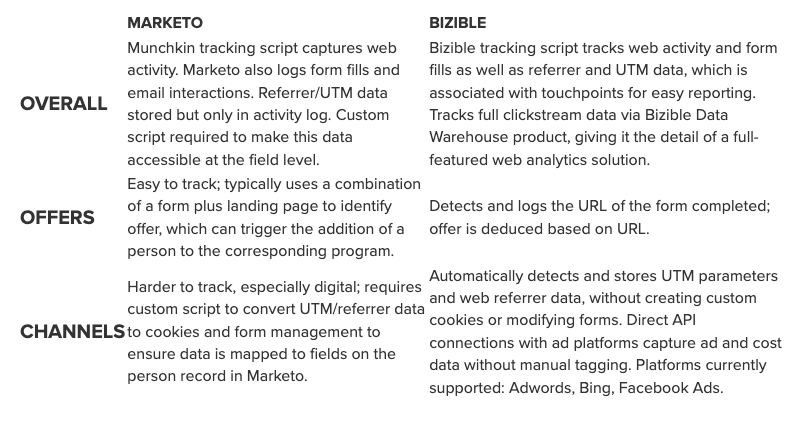
Data Modeling
The scenario: You’re launching a multi-faceted marketing campaign consisting of many offers (blog posts, webinars, ebooks, etc.) across numerous channels and your boss requires a report showing which channels are driving the most engagement with particular offers. In your preparations, you must also plan for the “human factor”— people who interact multiple times with a single channel.
The process with Marketo
Your set-up revolves around Marketo’s unit of attribution, the program, which represents a single marketing initiative you want to track. You can create as many programs as you like, and stages indicate the level of interaction with each program and if that interaction was successful. Programs correspond to a Salesforce campaign (if you track this in Salesforce). How do you capture the relationship between offers and channels?
Your options are less than ideal:
- Create separate programs for offers and channels: This allows you to capture each marketing asset and traffic source the person engages with, but there is no connection between them. Also, if someone engages with the same channel (e.g., organic Twitter) twice, you can’t track the second interaction, because a person can only be a member of a program once.
- Create a program for every offer + channel combo. Ex: ABC Ebook + social; ABC Ebook + paid search…and the list goes on. Prepare yourself for a mountain of work and huge task list to maintain.

- Copy UTM values to the campaign member, which also moves reporting to Salesforce (as you cannot store this additional metadata related to a specific program status in Marketo). This option gives you a more flexible model but requires extra configuration and custom code in Salesforce. Additionally, there are some challenges to tracking costs for ROI and reporting by channels with this method, as you no longer have a distinct campaign to represent the channel.
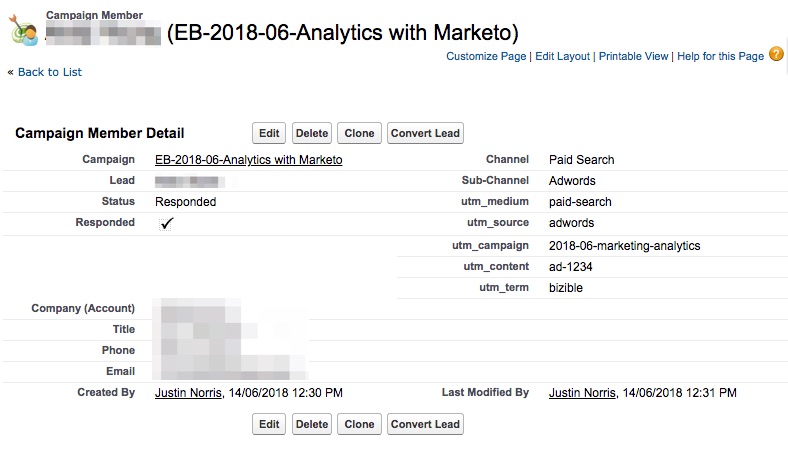
The process with Bizible
Bizible uses “touchpoints” (or the marketing interaction between a person, offer, and channel) as the unit of attribution and captures every web visit, form fill, and offline touchpoint, grouping them into channels or subchannels that you create. Theoretically, unlimited touchpoints are possible.
The process is straightforward as Bizible creates touchpoints automatically with little to set-up or maintain. Also nice, all interaction data, both offer and channel, are stored on the same record. As a result, there is greater flexibility in reporting options, including changing channel groupings midstream and reprocessing of all data without information loss.
The downside? You’ll have less rich metadata about offers, because the form URL isn’t as precise as the metadata associated with Marketo programs. For this reason, we recommend that you maintain offer programs in tandem in Marketo, which you would likely need anyway to send fulfillment emails, etc.
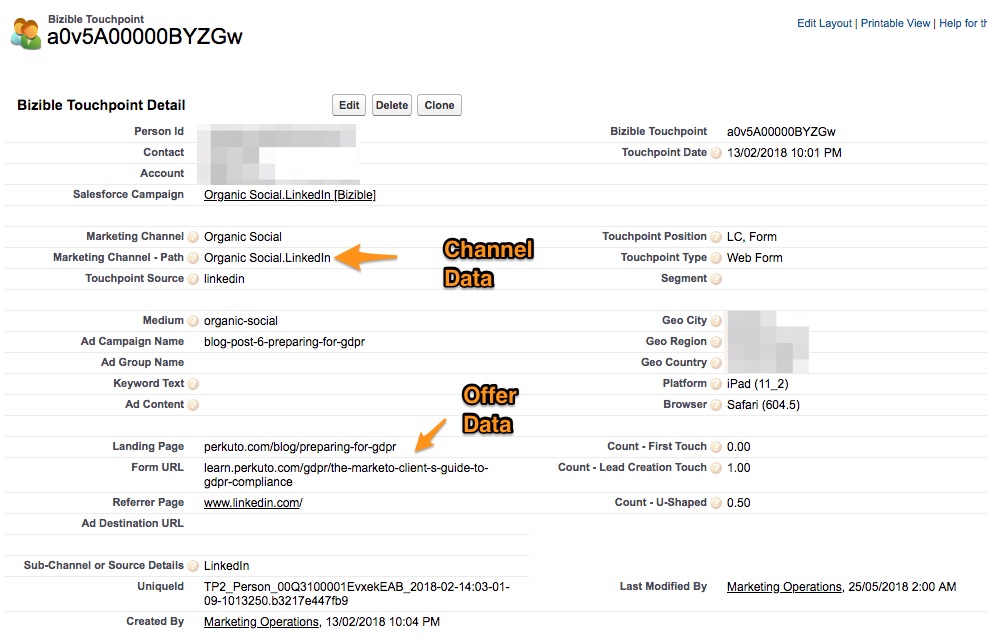
A Functional Comparison:
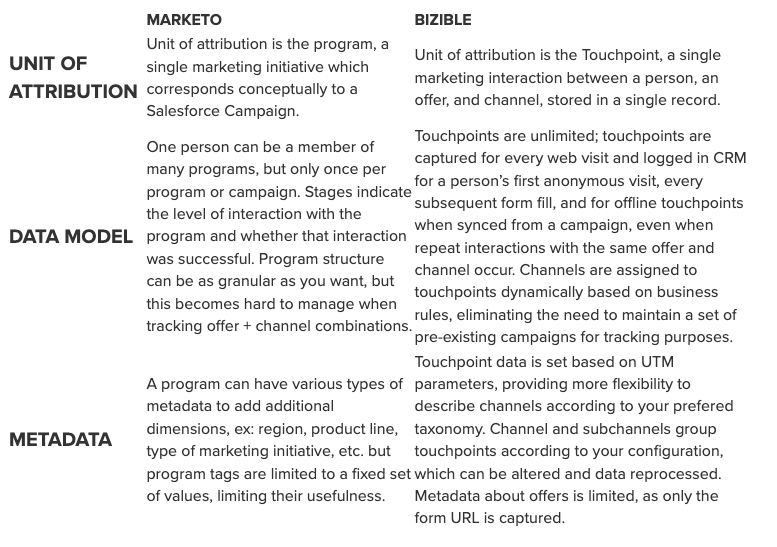
Data Reporting and Visualization
The scenario: You’ve completed your marketing campaign, and now it’s time for the fun part— reporting on the results. Your CMO is excited to see how each effort performed and eager to know which was the most profitable.
The process in Marketo
To run the requested reports and provide revenue attribution metrics, you’ll need Revenue Explorer or the newer Marketo Performance Insights (MPI) product. Both apply a multi-touch, even-split model to attribution with slight variances between the tools.
With RE, reporting visualization is pivot table style with some ability to create calculated fields and add custom dimensions; however, flexibility is limited and the calculated data is in a silo that can’t be connected to other sources.
The MPI reporting dashboard is more visually appealing, but customization is very limited and not designed for ad-hoc data exploration. Overall, if multi-touch, even-split attribution is not the model you want, then Marketo-based attribution does not meet your needs.
The process in Bizible
Bizible offers an array of choices for users accustomed to RE or MPI, including multiple attribution models ranging from traditional to complex plus a newer machine learning model. Determining which of your marketing efforts are most profitable is easier in Bizible, as it allows for more flexibility in manipulating and combining data with other objects and systems.
Moreover, because attribution calculations are stored in fields on CRM objects, you have full access to the native reporting capabilities of your CRM. The data is also accessible via API, can be added to other systems or exported to a data warehouse.
Marketers will also appreciate Bizible’s Discover UI, which is similar to MPI, for a familiar and aesthetically appealing view.
A Functional Comparison:
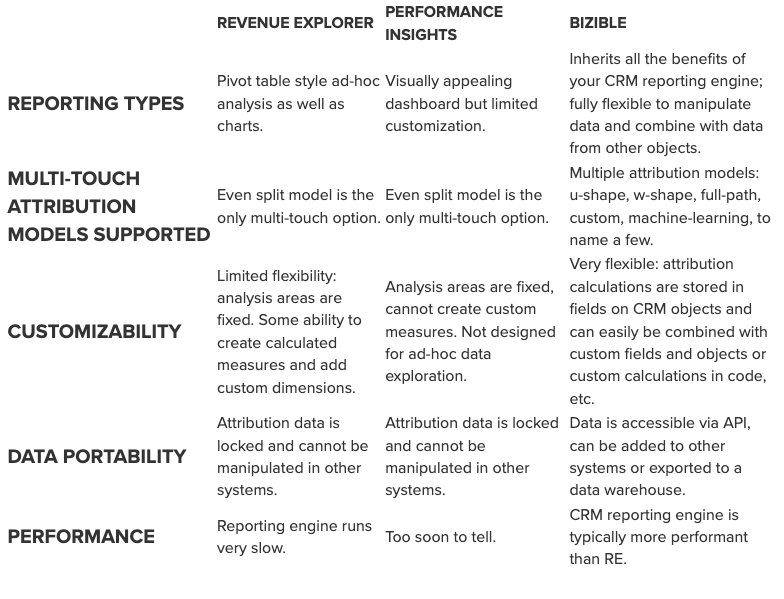
Which Tool Is Right for You?
Marketing isn’t getting any simpler. Instead, we’re working with more channels, more offers, and a non-linear customer journey. Marketo and Revenue Explorer track the offer and do simple attribution reporting reasonably well, but quickly become labor-intensive and extremely limited when attempting more complex analysis.
In contrast, Bizible offers easier tracking out of the box, less maintenance and work for marketing operations teams and more powerful (and flexible) reporting for CMOs. In short, Bizible does the heavy lifting that formerly required an extreme amount of work.
It’s not perfect, but we believe most Marketo users will quickly grow accustomed to the new GPS. The increased flexibility Bizible offers and reduced infrastructure it requires far outweigh any of its drawbacks and the improved directional insights will be appreciated throughout your organization.
And for those who want it all, Bizible is an easy stepping stone in your journey towards a full data warehouse.
We don’t know about you, but we’re all for better tools, simpler processes, and added conveniences.
Does your organization need help achieving ROI from Marketo? Learn how the Marketo experts at MERGE can help. Contact us today!
